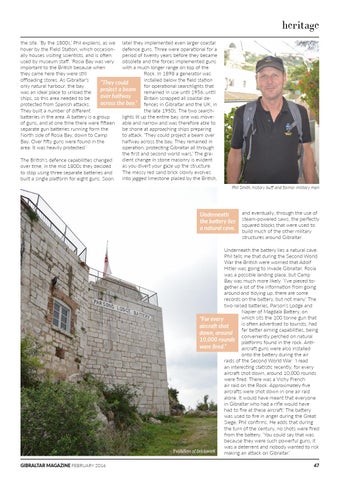heritage the site. ‘By the 1800s,’ Phil explains, as we later they implemented even larger coastal hover by the Field Station, which occasion- defence guns. Three were operational for a ally houses visiting scientists, and is often period of twenty years before they became obsolete and the forces implemented guns used by museum staff. ‘Rosia Bay was very important to the British because when with a much longer range on top of the Rock. In 1898 a generator was they came here they were still offloading stores. As Gibraltar’s installed below the field station “They could only natural harbour, the bay for operational searchlights that project a beam remained in use until 1956, until was an ideal place to unload the over halfway ships, so this area needed to be Britain scrapped all coastal deacross the bay.” fences in Gibraltar and the UK, in protected from Spanish attacks. They built a number of different the late 1950s. The two searchbatteries in the area. A battery is a group lights lit up the entire bay, one was moveof guns, and at one time there were fifteen able and narrow and was therefore able to separate gun batteries running form the be shone at approaching ships preparing North side of Rosia Bay, down to Camp to attack. ‘They could project a beam over Bay. Over fifty guns were found in the halfway across the bay. They remained in area. It was heavily protected.’ operation, protecting Gibraltar all through the first and second world wars.’ The gradient change in stone masonry is evident The British’s defence capabilities changed as you divert your gaze up the structure. over time, in the mid 1800s they decided The messy red sand brick slowly evolves to stop using three separate batteries and into jagged limestone placed by the British, built a single platform for eight guns. Soon Phil Smith, history buff and former military man
Underneath the battery lies a natural cave.
and eventually, through the use of steam-powered saws, the perfectly squared blocks that were used to build much of the other military structures around Gibraltar.
Underneath the battery lies a natural cave. Phil tells me that during the Second World War the British were worried that Adolf Hitler was going to invade Gibraltar. Rosia was a possible landing place, but Camp Bay was much more likely. ‘I’ve pieced together a lot of the information from going around and tidying up, there are some records on the battery, but not many.’ The two raised batteries, Parson’s Lodge and Napier of Magdala Battery, on which sits the 100 tonne gun that “For every is often advertised to tourists, had aircraft shot far better aiming capabilities, being down, around conveniently perched on natural 10,000 rounds platforms found in the rock. Antiwere fired.” aircraft guns were also installed onto the battery during the air raids of the Second World War. ‘I read an interesting statistic recently, for every aircraft shot down, around 10,000 rounds were fired. There was a Vichy French air raid on the Rock. Approximately five aircrafts were shot down in one air raid alone. It would have meant that everyone in Gibraltar who had a rifle would have had to fire at these aircraft.’ The battery was used to fire in anger during the Great Siege, Phil confirms. He adds that during the turn of the century, no shots were fired from the battery. ‘You could say that was because they were such powerful guns, it was a deterrent and nobody wanted to risk Evolution of brickwork making an attack on Gibraltar.’ GIBRALTAR MAGAZINE FEBRUARY 2016
47
